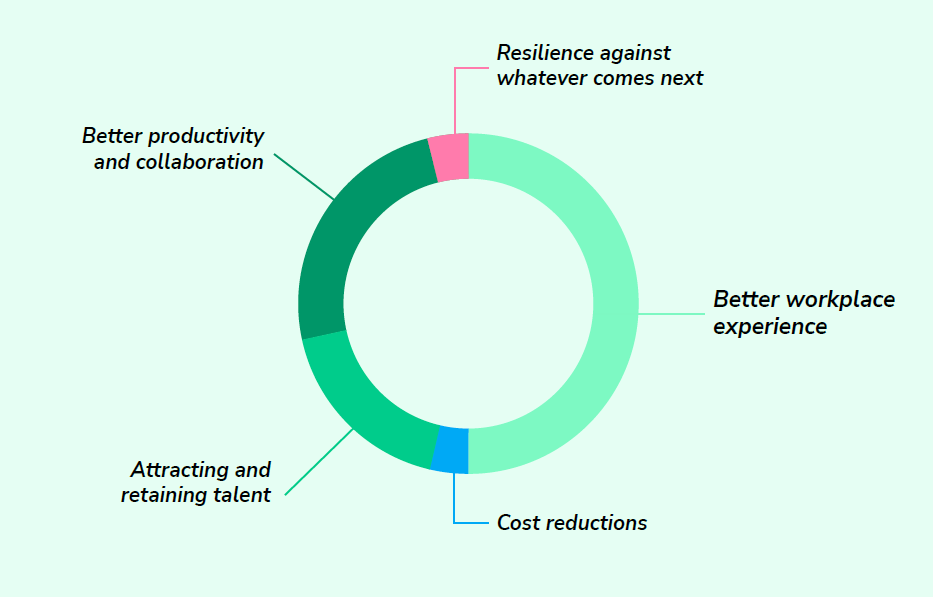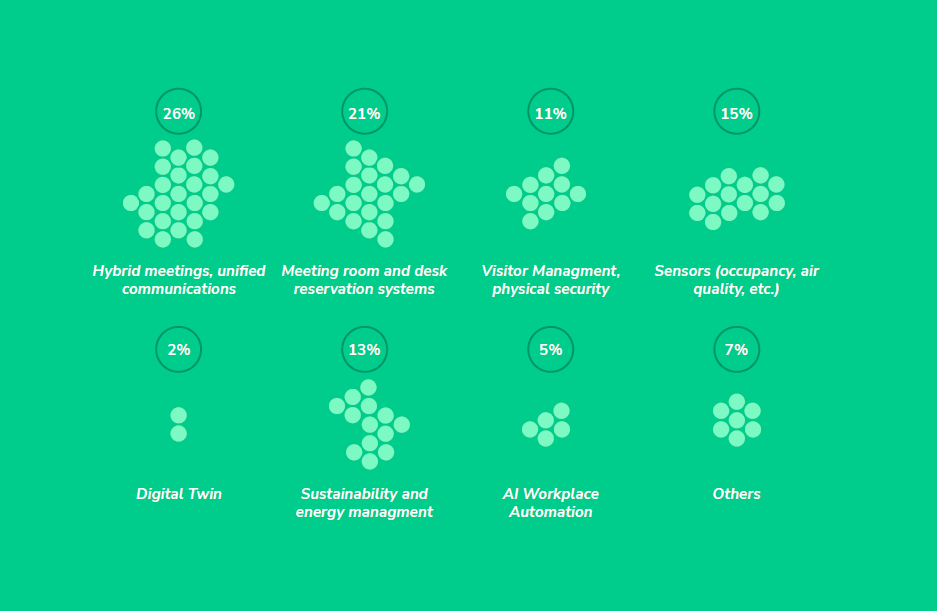This article originally appeared in the September/October 2022 issue of FMJ
by John C. Wang — Though employees have habituated to remote and hybrid working, for management it has been an arduous road when coming to terms with these new diverse working models and workplaces. This acceptance marks a done deal, and it is time for facility managers to reinvent the office once again.
During the pandemic, organizations quickly retrofitted their workspaces — adding on bits and pieces here and there — to support hybrid working styles for the short term. FMs must rebuild their workplaces from a hyper-hybrid-working-centric perspective. In these newly reinvented workplaces, employee experience will take priority in ways that champion more human interactions and connections. They will also level the playing field for on-site and remote employees that enables community and culture building.
To achieve this reinvention and avoid becoming overwhelmed, there are three essentials factors that ought to be prioritized:
- Technology must be equitable and inclusive to level the field for remote and on-site employees.
- Truly delivering on a workplace experience that delivers something the home office cannot and earning the commute of employees.
- As proven by the pandemic, staying agile is imperative; can the workplace adapt in five years, a year, or even the next six months to meet organizational and business needs?
Balancing the scales
An equitable and inclusive workplace is one in which all employees can feel valued while acknowledging their differences and their distinctive contributions to the organization. But as hybrid workplaces become the norm, these new environments are increasingly affecting equity and inclusivity.
Workplace equity and inclusive work culture can be achieved even while teams work in a hybrid manner. This can be done through ongoing adoption of technology, tools and applications that help keep people connected. As such, organizations are looking at technology that can give remote employees more of a form of permanence. How can FMs ensure remote employees are not de facto second-class employees?
This can be acutely evident when attending meetings that include both on-site and remote participants. When sharing a presentation, for example, remote employees’ faces can be shrunk down into tiny thumbnails, losing much of their presence within the space or even forgotten about entirely. They likely cannot see who is present in the meeting and may be unconsciously excluded from in-room discussion simply because they do not have a physical presence.
Furthermore, technology is just a tool. There is now also growing discussion regarding digital etiquette. Some companies invest as much in defining etiquette as they have spent on the technology itself. Etiquette is an absolute necessity to ensure remote participants are included. It is essential to invest both money and effort into defining and teaching healthy and respectful practices — perhaps more even than the technology itself.
The employee experience
If employers want people back in the office, how do they earn the commute of the employee, and what is the value at the end of that commute? These are timely questions as the costs of fuel and living soar. A vast majority will opt for the home office. However, when there is a genuine reason to go to the office, such as tasks that are collaboration-centric, people will choose to go in. Employers then must provide the types of services that satisfy the reasons for which employees come in.
There is a real need to uplift technology. On entering a conference room back in 2018 for example, it was expected that something would be under par: a weak Wi-Fi signal, disconnected phones or malfunctioning display equipment. Considering the workplace landscape now, and where it is moving to, if employers want to earn that commute and offer a great workplace experience, broken technology is not going to cut it. Employees have invested this effort to go to the office, and when something does not work, they are going to say, “For the last two years I’ve worked at home; I worked better there, so I’m just not going to come in again.”
In the IT world, the data center has been around for many years. The CIO could look at their data center and know the speed of the fans in a server, how much power is being drawn, and other minute details. The workplace ought to be viewed from a similar perspective and down to a greater level of detail. Organizations are aware of just how much it costs per minute when any part of the enterprise network is down. So, too, should they be aware of the lost revenue and productivity when any other system in the workplace is down, and as something that must be kept operational.
Bringing up the capability of both video and audio technology, as well as digital collaboration capabilities such as digital white boarding, will make or break the decision to come to the office.
Keep on your toes
Designing for agility is a must in the workplace or facilities that FMs are trying to reinvent. Six months from now, should employees need to return to total remote work or all return to the office, there must be agility in what has been created so far to enable that.
As such, facilities should be viewed as something fluid and mobile, rather than a static entity. Championing a collaborative experience in the office is priority. But moving forward, organizational leaders will be asking — given that real estate is the second biggest expense after people and people are changing where and how they work — are there efficiencies that can be gained? Real estate heads are hesitant because it is easier to cut it than it is to get it back. Many err on the side of caution, lacking definitive data to guide decision making and this is operating against organizations that want to be agile.
As a property portfolio grows, so does the aversion to change. When dealing with 50, 100 or even 200 buildings, where does one focus time and investment? Should buildings be reinvented one at a time, or across all buildings simultaneously? Working out where to start is the primary challenge. There is much to do in building the office or workplace of the future. Where large organizations start and what they prioritize is of particular importance.
As the global situation continues to be unsettled, over the next couple of years especially, staying agile will grow increasingly important. Agility will be achieved through greater uptake of technology that can supply data for analysis to guide decision making. It will solve immediate challenges, namely getting people productive in the workplace (and even when these needs change due to external factors), and in offering the variety of spaces employees need. It will also solve long-term challenges, such as rightsizing of the organization’s footprint to meet evolving business requirements.
There is no single recipe for what is right. But as organizations contend with reinventing themselves with agility in mind, understanding which employees are coming in, why they choose to do so and what they are doing when they come in, leaders can adjust and tweak the environment, providing more of what employees want and remove what is being underutilized.
Final words
It may seem a lot to contend with when reinventing the workspace once again to embody hybrid working at its core. But with such a vibrant range of tools and a potent portfolio of technologies available, it is a golden age for FMs. Never more so has the profession had an opportunity to impact not only the workplace experience of employees, but also performance of organizations in a positive manner. Technology has enabled them to craft an environment that focuses on the well-being of people, allowing them to stay productive by offering them something unique that the home office cannot.
It also extends beyond the walls of the workplace itself, encircling remote employees even if they are not physically present. Through greater digital etiquette and supporting tools, the workplace can be truly equitable and inclusive. Lastly, this new reinvention is by no means fixed; by incorporating the concept of staying agile, it can be tweaked and reworked to meet business needs of both the now, the tomorrow and well into the future.
| Fig. 1: What is the primary goal for adopting hybrid work models? | Votes |
| Resilience against whatever comes next | 1 |
| Better workplace experience | 11 |
| Cost reductions | 1 |
| Attracting and retaining talent | 4 |
| Better productivity and collaboration | 5 |
| Fig. 2: Which technologies are being prioritized to support hybrid workplaces? | Votes |
| Hybrid meetings and unified communications | 20% |
| Meeting room and desk reservation systems | 21% |
| Visitor management and digital security | 11% |
| Sensors (occupancy, air quality, etc.) | 15% |
| Digital twins | 2% |
| Sustainability and energy management | 13% |
| AI workplace automation | 5% |
| Other | 7% |
 John C. Wang is co-founder and CEO of IAdea Corporation. Passionate about the current and future development of the digital signage industry, Wang co-founded the web-based Signage Business Group at the World Wide Web Consortium. He serves as the vice chairman of the Digital Solutions Multimedia Asia (DSMA), a non-profit industry group comprising of over 200 member companies throughout Asia. He received his master’s degree in computer science from the National Taiwan University.
John C. Wang is co-founder and CEO of IAdea Corporation. Passionate about the current and future development of the digital signage industry, Wang co-founded the web-based Signage Business Group at the World Wide Web Consortium. He serves as the vice chairman of the Digital Solutions Multimedia Asia (DSMA), a non-profit industry group comprising of over 200 member companies throughout Asia. He received his master’s degree in computer science from the National Taiwan University.

